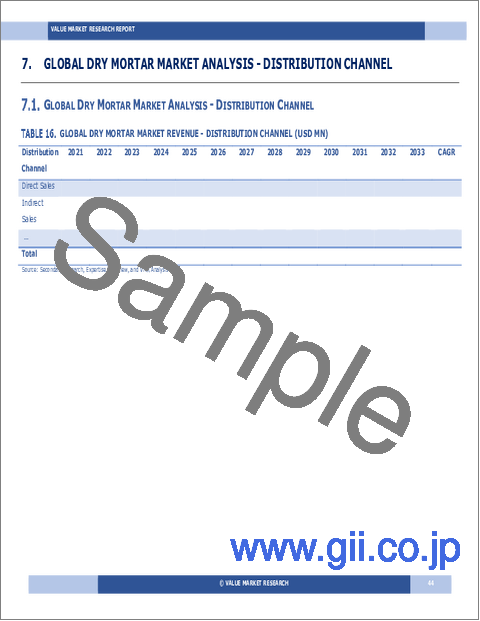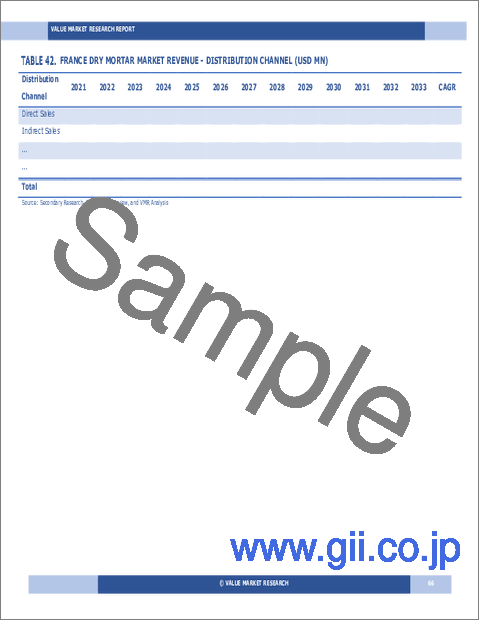|
|
市場調査レポート
商品コード
1743848
乾式モルタルの世界市場:産業分析、市場規模・シェア・成長率・動向・予測 (2025年~2033年)Global Dry Mortar Market Research Report- Industry Analysis, Size, Share, Growth, Trends and Forecast 2025 to 2033 |
||||||
カスタマイズ可能
|
|||||||
| 乾式モルタルの世界市場:産業分析、市場規模・シェア・成長率・動向・予測 (2025年~2033年) |
|
出版日: 2025年06月01日
発行: Value Market Research
ページ情報: 英文 139 Pages
納期: 即日から翌営業日
|
全表示
- 概要
- 図表
- 目次
世界の乾式モルタルの市場規模は、2024年の388億9,000万米ドルから2033年には690億1,000万米ドルに成長し、2026年から2033年の予測期間中に6.58%の堅調な年間平均成長率(CAGR)を示すと予測されています。
乾式モルタル市場は、建設業界の継続的な拡大と効率的な建築材料に対する需要の高まりに後押しされ、大幅な成長を遂げる見通しです。世界的に都市化が加速するにつれ、高性能な建築ソリューションの必要性が最も高まっています。使いやすさと優れた接着特性で知られる乾式モルタルは、建設効率の向上を目指す建設業者や請負業者の間で支持を集めています。プレハブ建築やモジュール建築技術へのシフトは、乾式モルタルの需要をさらに増大させています。これらの工法では、最適な性能を発揮するために信頼性の高い一貫した材料が必要とされるからです。
建設動向に加え、乾式モルタル市場では、特に特殊な配合の開発において技術革新が急増しています。メーカーは、タイル接着剤、左官用コンパウンド、補修用モルタルなど、特定の用途に対応する製品の開発にますます力を入れるようになっています。この動向は、建設部門の多様なニーズに対応するだけでなく、建築プロジェクトの全体的な品質と耐久性を高める。建築基準が進化するにつれて、高品質の乾式モルタルソリューションに対する需要は高まり続け、研究開発を優先するメーカーは市場の最前線に位置づけられます。
さらに、建設業界における持続可能性の重視の高まりは、乾式モルタル市場の将来を形作ると思われます。建設業者は環境への影響を最小限に抑えようとするため、環境に優しく低排出ガス製品の需要が高まると思われます。リサイクル材料の利用や生産時のエネルギー消費の削減など、持続可能な慣行に投資するメーカーは、競争上の優位性を獲得する可能性が高いです。このような持続可能性の目標との一致は、環境意識の高い消費者を引きつけるだけでなく、ますます厳しくなる規制への準拠を確実にします。このように、乾式モルタル市場は、革新性、持続可能性、建設資材の品質へのこだわりを特徴とする未来に向けた態勢を整えています。
当社のレポートは、様々な業界や市場に関する包括的かつ実用的な洞察をお客様に提供するために綿密に作成されています。各レポートは、市場情勢を完全に理解するために、いくつかの重要な要素を含んでいます:
市場概要:定義、分類、業界の現状など、市場に関する詳細情報。
市場力学:市場成長に影響を与える主な促進要因・抑制要因・機会・課題を詳細に分析します。このセクションでは、技術の進歩、規制の変更、新たな動向などの要因を検証します。
セグメンテーション分析:製品種類、用途、エンドユーザー、地域などの基準に基づき、市場を明確なセグメントに分類します。この分析により、各セグメントの業績と将来性を明らかにします。
競合情勢:市場シェア、製品ポートフォリオ、戦略的イニシアティブ、財務実績など、主要企業を包括的に評価します。主要企業が採用する競合力学と主要戦略に関する考察を提供します。
市場予測:過去のデータと現在の市場状況に基づき、一定期間における市場規模と成長動向を予測します。これには、定量的分析と将来の市場軌跡を示すグラフ表示が含まれます。
地域分析:地域ごとの市場パフォーマンスを評価し、主要市場や地域動向を明らかにします。地域の市場力学とビジネスチャンスを理解するのに役立ちます。
新たな動向と機会:現在・将来の市場動向、技術革新、潜在的な投資対象分野を特定します。将来の市場発展・成長見通しに関する洞察を提供します。
目次
第1章 序文
第2章 エグゼクティブサマリー
- 市場のハイライト
- 世界市場スナップショット
第3章 乾式モルタル:産業分析
- イントロダクション:市場力学
- 市場促進要因
- 市場抑制要因
- 市場機会
- 業界動向
- ポーターのファイブフォース分析
- 市場魅力分析
第4章 バリューチェーン分析
- バリューチェーン分析
- 原材料分析
- 原材料リスト
- 原材料メーカーリスト
- 主要原材料の価格動向
- 潜在的バイヤーの一覧
- マーケティングチャネル
- 直接的マーケティング
- 間接的マーケティング
- マーケティングチャネルの発展動向
第5章 世界の乾式モルタル市場の分析:製品種類別
- 市場概要:製品種類別
- 実績・予測データ分析:製品種類別
- レンガ敷き/石工用モルタル
- 床面用スクリード
- タイル用接着剤・グラウト
- 壁用レンダー・プラスター
- その他
第6章 世界の乾式モルタル市場の分析:用途別
- 市場概要:用途別
- 実績・予測データ分析:用途別
- 住宅用
- 商業用
- 工業用
- インフラ
第7章 世界の乾式モルタル市場の分析:流通チャネル別
- 市場概要:流通チャネル別
- 実績・予測データ分析:流通チャネル別
- 直接販売
- 間接販売
第8章 世界の乾式モルタル市場の分析:地域別
- 地域別の展望
- イントロダクション
- 北米の売上高の分析
- 概要・実績・予測
- 北米:セグメント別
- 北米:国別
- 米国
- カナダ
- メキシコ
- 欧州の売上高の分析
- 概要・実績・予測
- 欧州:セグメント別
- 欧州:国別
- 英国
- フランス
- ドイツ
- イタリア
- ロシア
- その他欧州
- アジア太平洋の売上高の分析
- 概要・実績・予測
- アジア太平洋:セグメント別
- アジア太平洋:国別
- 中国
- インド
- 日本
- 韓国
- オーストラリア
- 東南アジア
- その他アジア太平洋
- ラテンアメリカの売上高の分析
- 概要・実績・予測
- ラテンアメリカ:セグメント別
- ラテンアメリカ:国別
- ブラジル
- アルゼンチン
- ペルー
- チリ
- その他ラテンアメリカ
- 中東・アフリカの売上高の分析
- 概要・実績・予測
- 中東・アフリカ:セグメント別
- 中東・アフリカ:国別
- サウジアラビア
- アラブ首長国連邦
- イスラエル
- 南アフリカ
- その他中東・アフリカ
第9章 乾式モルタル企業の競合情勢
- 乾式モルタル市場の競合
- 提携・協力・合意
- 企業合併・買収 (M&A)
- 新製品発表
- その他の動向
第10章 企業プロファイル
- 上位企業の市場シェア分析
- 市場集中度
- Saint-Gobain
- BASF SE
- Dow Inc.
- Sika AG
- Henkel AG & Co. KGaA
- Holcim Ltd.
- Akzo Nobel N.V.
- Wacker Chemie AG
- H.B. Fuller Company
- Cemex S.A.B. De C.V.
- Mapei S.P.A.
- Bostik(Arkema Group)
- Ardex Group
- Knauf Gips KG
- Parex Group
LIST OF TABLES
- Market Snapshot
- Drivers: Impact Analysis
- Restraints: Impact Analysis
- List of Raw Material
- List of Raw Material Manufactures
- Analysis By Product Type (USD MN)
- Bricklaying/Masonry Mortar Market Sales By Geography (USD MN)
- Floor Screed Market Sales By Geography (USD MN)
- Tile Adhesives and Grouts Market Sales By Geography (USD MN)
- Wall Renders and Plasters Market Sales By Geography (USD MN)
- Others Market Sales By Geography (USD MN)
- Analysis By Application (USD MN)
- Residential Market Sales By Geography (USD MN)
- Commercial Market Sales By Geography (USD MN)
- Industrial Market Sales By Geography (USD MN)
- Infrastructure Market Sales By Geography (USD MN)
- Analysis By Distribution Channel (USD MN)
- Direct Sales Market Sales By Geography (USD MN)
- Indirect Sales Market Sales By Geography (USD MN)
- Global Dry Mortar Market Sales By Geography (USD MN)
- North America Market Analysis (USD MN)
- United States Market Analysis (USD MN)
- Canada Market Analysis (USD MN)
- Mexico Market Analysis (USD MN)
- Europe Market Analysis (USD MN)
- Europe Market Estimate By Country (USD MN)
- United Kingdom Market Analysis (USD MN)
- France Market Analysis (USD MN)
- Germany Market Analysis (USD MN)
- Italy Market Analysis (USD MN)
- Russia Market Analysis (USD MN)
- Spain Market Analysis (USD MN)
- Rest of Europe Market Analysis (USD MN)
- Asia Pacific Market Analysis (USD MN)
- China Market Analysis (USD MN)
- Japan Market Analysis (USD MN)
- India Market Analysis (USD MN)
- South Korea Market Analysis (USD MN)
- Australia Market Analysis (USD MN)
- South East Asia Market Analysis (USD MN)
- Rest of Asia Pacific Market Analysis (USD MN)
- Latin America Market Analysis (USD MN)
- Brazil Market Analysis (USD MN)
- Argentina Market Analysis (USD MN)
- Peru Market Analysis (USD MN)
- Chile Market Analysis (USD MN)
- Rest of Latin America Market Analysis (USD MN)
- Middle East & Africa Market Analysis (USD MN)
- Saudi Arabia Market Analysis (USD MN)
- UAE Market Analysis (USD MN)
- Israel Market Analysis (USD MN)
- South Africa Market Analysis (USD MN)
- Rest of Middle East and Africa Market Analysis (USD MN)
- Partnership/Collaboration/Agreement
- Mergers And Acquisition
LIST OF FIGURES
- Research Scope of Dry Mortar Report
- Market Research Process
- Market Research Methodology
- Global Dry Mortar Market Size, By Regions (USD MN)
- Porters Five Forces Analysis
- Market Attractiveness Analysis By Product Type
- Market Attractiveness Analysis By Application
- Market Attractiveness Analysis By Distribution Channel
- Market Attractiveness Analysis By Regions
- Value Chain Analysis
- Global Market Analysis By Product Type (USD MN)
- Bricklaying/Masonry Mortar Market Sales By Geography (USD MN)
- Floor Screed Market Sales By Geography (USD MN)
- Tile Adhesives and Grouts Market Sales By Geography (USD MN)
- Wall Renders and Plasters Market Sales By Geography (USD MN)
- Others Market Sales By Geography (USD MN)
- Global Market Analysis By Application (USD MN)
- Residential Market Sales By Geography (USD MN)
- Commercial Market Sales By Geography (USD MN)
- Industrial Market Sales By Geography (USD MN)
- Infrastructure Market Sales By Geography (USD MN)
- Global Market Analysis By Distribution Channel (USD MN)
- Direct Sales Market Sales By Geography (USD MN)
- Indirect Sales Market Sales By Geography (USD MN)
- Global Market Sales (USD MN)
- North America Market Sales (USD MN)
- Europe Market Sales (USD MN)
- Asia Pacific Market Sales (USD MN)
- Latin America Market Sales (USD MN)
- Middle East & Africa Market Sales (USD MN)
- Recent Development in Industry
- Top Company Market Share Analysis
Kindly note that the above listed are the basic tables and figures of the report and are not limited to the TOC.
Global Dry Mortar Market size is anticipated to grow from USD 38.89 Billion in 2024 to USD 69.01 Billion by 2033, showcasing a robust Compound Annual Growth Rate (CAGR) of 6.58% during the forecast period of 2026 to 2033.
The dry mortar market is set to experience substantial growth, fueled by the ongoing expansion of the construction industry and the increasing demand for efficient building materials. As urbanization accelerates globally, the need for high-performance construction solutions becomes paramount. Dry mortar, known for its ease of use and superior bonding properties, is gaining traction among builders and contractors seeking to enhance construction efficiency. The shift towards prefabricated and modular construction techniques further amplifies the demand for dry mortar, as these methods require reliable and consistent materials for optimal performance.
In addition to construction trends, the dry mortar market is witnessing a surge in innovation, particularly in the development of specialized formulations. Manufacturers are increasingly focusing on creating products that cater to specific applications, such as tile adhesives, plastering compounds, and repair mortars. This trend not only addresses the diverse needs of the construction sector but also enhances the overall quality and durability of building projects. As construction standards evolve, the demand for high-quality dry mortar solutions will continue to rise, positioning manufacturers who prioritize research and development at the forefront of the market.
Moreover, the growing emphasis on sustainability within the construction industry will shape the future of the dry mortar market. As builders seek to minimize their environmental footprint, the demand for eco-friendly and low-emission products will increase. Manufacturers that invest in sustainable practices, such as utilizing recycled materials and reducing energy consumption during production, will likely gain a competitive advantage. This alignment with sustainability goals will not only attract environmentally conscious consumers but also ensure compliance with increasingly stringent regulations. The dry mortar market is thus poised for a future characterized by innovation, sustainability, and a commitment to quality in construction materials.
Our reports are meticulously crafted to provide clients with comprehensive and actionable insights into various industries and markets. Each report encompasses several critical components to ensure a thorough understanding of the market landscape:
Market Overview: A detailed introduction to the market, including definitions, classifications, and an overview of the industry's current state.
Market Dynamics: In-depth analysis of key drivers, restraints, opportunities, and challenges influencing market growth. This section examines factors such as technological advancements, regulatory changes, and emerging trends.
Segmentation Analysis: Breakdown of the market into distinct segments based on criteria like product type, application, end-user, and geography. This analysis highlights the performance and potential of each segment.
Competitive Landscape: Comprehensive assessment of major market players, including their market share, product portfolio, strategic initiatives, and financial performance. This section provides insights into the competitive dynamics and key strategies adopted by leading companies.
Market Forecast: Projections of market size and growth trends over a specified period, based on historical data and current market conditions. This includes quantitative analyses and graphical representations to illustrate future market trajectories.
Regional Analysis: Evaluation of market performance across different geographical regions, identifying key markets and regional trends. This helps in understanding regional market dynamics and opportunities.
Emerging Trends and Opportunities: Identification of current and emerging market trends, technological innovations, and potential areas for investment. This section offers insights into future market developments and growth prospects.
SEGMENTATION COVERED IN THE REPORT
By Product Type
- Bricklaying/Masonry Mortar
- Floor Screed
- Tile Adhesives and Grouts
- Wall Renders and Plasters
- Others
By Application
- Residential
- Commercial
- Industrial
- Infrastructure
By Distribution Channel
- Direct Sales
- Indirect Sales
- COMPANIES PROFILED
- Saint-Gobain
- BASF SE
- Dow Inc.
- Sika AG
- Henkel AG & Co. KGaA
- Holcim Ltd.
- Akzo Nobel N.V.
- Wacker Chemie AG
- H.B. Fuller Company
- Cemex S.A.B. de C.V.
- Mapei S.p.A.
- Bostik (Arkema Group)
- Ardex Group
- Knauf Gips KG
- Parex Group
- The above list can be customized.
TABLE OF CONTENTS
1. PREFACE
- 1.1. Report Description
- 1.1.1 Objective
- 1.1.2 Target Audience
- 1.1.3 Unique Selling Proposition (USP) & offerings
- 1.2. Research Scope
- 1.3. Research Methodology
- 1.3.1 Market Research Process
- 1.3.2 Market Research Methodology
2. EXECUTIVE SUMMARY
- 2.1. Highlights of Market
- 2.2. Global Market Snapshot
3. DRY MORTAR INDUSTRY ANALYSIS
- 3.1. Introduction - Market Dynamics
- 3.2. Market Drivers
- 3.3. Market Restraints
- 3.4. Opportunities
- 3.5. Industry Trends
- 3.6. Porter's Five Force Analysis
- 3.7. Market Attractiveness Analysis
- 3.7.1 Market Attractiveness Analysis By Product Type
- 3.7.2 Market Attractiveness Analysis By Application
- 3.7.3 Market Attractiveness Analysis By Distribution Channel
- 3.7.4 Market Attractiveness Analysis By Regions
4. VALUE CHAIN ANALYSIS
- 4.1. Value Chain Analysis
- 4.2. Raw Material Analysis
- 4.2.1 List of Raw Materials
- 4.2.2 Raw Material Manufactures List
- 4.2.3 Price Trend of Key Raw Materials
- 4.3. List of Potential Buyers
- 4.4. Marketing Channel
- 4.4.1 Direct Marketing
- 4.4.2 Indirect Marketing
- 4.4.3 Marketing Channel Development Trend
5. GLOBAL DRY MORTAR MARKET ANALYSIS BY PRODUCT TYPE
- 5.1. Overview By Product Type
- 5.2. Historical and Forecast Data Analysis By Product Type
- 5.3. Bricklaying/Masonry Mortar Historic and Forecast Sales By Regions
- 5.4. Floor Screed Historic and Forecast Sales By Regions
- 5.5. Tile Adhesives and Grouts Historic and Forecast Sales By Regions
- 5.6. Wall Renders and Plasters Historic and Forecast Sales By Regions
- 5.7. Others Historic and Forecast Sales By Regions
6. GLOBAL DRY MORTAR MARKET ANALYSIS BY APPLICATION
- 6.1. Overview By Application
- 6.2. Historical and Forecast Data Analysis By Application
- 6.3. Residential Historic and Forecast Sales By Regions
- 6.4. Commercial Historic and Forecast Sales By Regions
- 6.5. Industrial Historic and Forecast Sales By Regions
- 6.6. Infrastructure Historic and Forecast Sales By Regions
7. GLOBAL DRY MORTAR MARKET ANALYSIS BY DISTRIBUTION CHANNEL
- 7.1. Overview By Distribution Channel
- 7.2. Historical and Forecast Data Analysis By Distribution Channel
- 7.3. Direct Sales Historic and Forecast Sales By Regions
- 7.4. Indirect Sales Historic and Forecast Sales By Regions
8. GLOBAL DRY MORTAR MARKET ANALYSIS BY GEOGRAPHY
- 8.1. Regional Outlook
- 8.2. Introduction
- 8.3. North America Sales Analysis
- 8.3.1 Overview, Historic and Forecast Data Sales Analysis
- 8.3.2 North America By Segment Sales Analysis
- 8.3.3 North America By Country Sales Analysis
- 8.3.4 United States Sales Analysis
- 8.3.5 Canada Sales Analysis
- 8.3.6 Mexico Sales Analysis
- 8.4. Europe Sales Analysis
- 8.4.1 Overview, Historic and Forecast Data Sales Analysis
- 8.4.2 Europe By Segment Sales Analysis
- 8.4.3 Europe By Country Sales Analysis
- 8.4.4 United Kingdom Sales Analysis
- 8.4.5 France Sales Analysis
- 8.4.6 Germany Sales Analysis
- 8.4.7 Italy Sales Analysis
- 8.4.8 Russia Sales Analysis
- 8.4.9 Rest Of Europe Sales Analysis
- 8.5. Asia Pacific Sales Analysis
- 8.5.1 Overview, Historic and Forecast Data Sales Analysis
- 8.5.2 Asia Pacific By Segment Sales Analysis
- 8.5.3 Asia Pacific By Country Sales Analysis
- 8.5.4 China Sales Analysis
- 8.5.5 India Sales Analysis
- 8.5.6 Japan Sales Analysis
- 8.5.7 South Korea Sales Analysis
- 8.5.8 Australia Sales Analysis
- 8.5.9 South East Asia Sales Analysis
- 8.5.10 Rest Of Asia Pacific Sales Analysis
- 8.6. Latin America Sales Analysis
- 8.6.1 Overview, Historic and Forecast Data Sales Analysis
- 8.6.2 Latin America By Segment Sales Analysis
- 8.6.3 Latin America By Country Sales Analysis
- 8.6.4 Brazil Sales Analysis
- 8.6.5 Argentina Sales Analysis
- 8.6.6 Peru Sales Analysis
- 8.6.7 Chile Sales Analysis
- 8.6.8 Rest of Latin America Sales Analysis
- 8.7. Middle East & Africa Sales Analysis
- 8.7.1 Overview, Historic and Forecast Data Sales Analysis
- 8.7.2 Middle East & Africa By Segment Sales Analysis
- 8.7.3 Middle East & Africa By Country Sales Analysis
- 8.7.4 Saudi Arabia Sales Analysis
- 8.7.5 UAE Sales Analysis
- 8.7.6 Israel Sales Analysis
- 8.7.7 South Africa Sales Analysis
- 8.7.8 Rest Of Middle East And Africa Sales Analysis
9. COMPETITIVE LANDSCAPE OF THE DRY MORTAR COMPANIES
- 9.1. Dry Mortar Market Competition
- 9.2. Partnership/Collaboration/Agreement
- 9.3. Merger And Acquisitions
- 9.4. New Product Launch
- 9.5. Other Developments
10. COMPANY PROFILES OF DRY MORTAR INDUSTRY
- 10.1. Top Companies Market Share Analysis
- 10.2. Market Concentration Rate
- 10.3. Saint-Gobain
- 10.3.1 Company Overview
- 10.3.2 Company Revenue
- 10.3.3 Products
- 10.3.4 Recent Developments
- 10.4. BASF SE
- 10.4.1 Company Overview
- 10.4.2 Company Revenue
- 10.4.3 Products
- 10.4.4 Recent Developments
- 10.5. Dow Inc.
- 10.5.1 Company Overview
- 10.5.2 Company Revenue
- 10.5.3 Products
- 10.5.4 Recent Developments
- 10.6. Sika AG
- 10.6.1 Company Overview
- 10.6.2 Company Revenue
- 10.6.3 Products
- 10.6.4 Recent Developments
- 10.7. Henkel AG & Co. KGaA
- 10.7.1 Company Overview
- 10.7.2 Company Revenue
- 10.7.3 Products
- 10.7.4 Recent Developments
- 10.8. Holcim Ltd.
- 10.8.1 Company Overview
- 10.8.2 Company Revenue
- 10.8.3 Products
- 10.8.4 Recent Developments
- 10.9. Akzo Nobel N.V.
- 10.9.1 Company Overview
- 10.9.2 Company Revenue
- 10.9.3 Products
- 10.9.4 Recent Developments
- 10.10. Wacker Chemie AG
- 10.10.1 Company Overview
- 10.10.2 Company Revenue
- 10.10.3 Products
- 10.10.4 Recent Developments
- 10.11. H.B. Fuller Company
- 10.11.1 Company Overview
- 10.11.2 Company Revenue
- 10.11.3 Products
- 10.11.4 Recent Developments
- 10.12. Cemex S.A.B. De C.V.
- 10.12.1 Company Overview
- 10.12.2 Company Revenue
- 10.12.3 Products
- 10.12.4 Recent Developments
- 10.13. Mapei S.P.A.
- 10.13.1 Company Overview
- 10.13.2 Company Revenue
- 10.13.3 Products
- 10.13.4 Recent Developments
- 10.14. Bostik (Arkema Group)
- 10.14.1 Company Overview
- 10.14.2 Company Revenue
- 10.14.3 Products
- 10.14.4 Recent Developments
- 10.15. Ardex Group
- 10.15.1 Company Overview
- 10.15.2 Company Revenue
- 10.15.3 Products
- 10.15.4 Recent Developments
- 10.16. Knauf Gips KG
- 10.16.1 Company Overview
- 10.16.2 Company Revenue
- 10.16.3 Products
- 10.16.4 Recent Developments
- 10.17. Parex Group
- 10.17.1 Company Overview
- 10.17.2 Company Revenue
- 10.17.3 Products
- 10.17.4 Recent Developments





